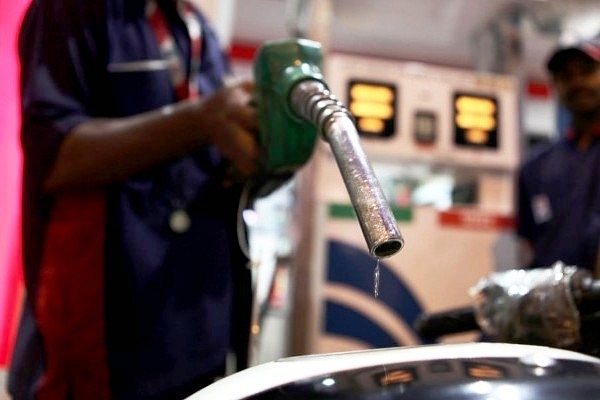News Brief
Explained: The Cost Of Fuel Price Cuts For The Government
- With the excise cuts announced on Sunday, the excise duty hikes from 2020 have now been fully reversed.
- While this brings much needed relief to the people, it levies a massive burden on the government.

A car owner gets his fuel tank filled with petrol from a petrol pump at Prabhadevi. (Sattish Bate/Hindustan Times via Getty Images)
Good politics is not always good economics. While giving a big relief to the common man and staving off opposition heat on spiralling inflation, the Government’s decision to cut excise duty on petrol by Rs 8/litre and diesel by Rs 6/litre is going to burn a hole in its coffers.
Rising global oil prices triggered by geopolitical tensions and Russian invasion of Ukraine have led to sharp increase in fuel prices as oil marketing companies were forced to pass on the high cost of importing fuel to consumers.
The current cut in fuel excise duties follows the one announced in November 2021 of Rs 5/litre for petrol and Rs 10/litre for diesel.
With the excise cuts announced on Sunday, the excise duty hikes from 2020 to the tune of Rs 13/litre and Rs 16/litre for petrol and diesel, respectively, have now been fully reversed.
As state governments apply an ad-valorem tax on fuel products - petrol and diesel fall outside of the GST’s purview - so the net impact on the consumer will be larger. This in government estimates, will effectively reduce the final prices of petrol and diesel by Rs 9.5/litre (8.4 per cent) and Rs 7/litre (6.9 per cent), respectively.
According to Nomura economist, Sonal Varma, the latest cuts are likely to cost the government Rs 1 trillion or 0.4 per cent of GDP annually. The burden on the Government would be Rs 850 billion for the remaining months in FY23. The government has also announced a subsidy of Rs 200/cylinder (for up to 12 cylinders) for low income households, aimed at 90 mn beneficiaries, which is likely to cost Rs 61 billion amounting to 0.02 per cent of GDP.
The Government had few choices.
April’s CPI inflation reached an 8-year high of 7.8 per cent y-o-y from 7.0 per cent in March, above expectations, reflecting a broad-based rise across food, fuel and core inflation (to 7.0 per cent from 6.4 per cent), and a higher-than-expected jump in the fuel basket led by LPG, electricity and kerosene prices.
Under political fire and widespread flak for imposing a burden on people still reeling under the economic shock of the pandemic, the Centre announced the excise cuts which will lower pump prices by 7-8 per cent immediately, and potentially more if states also lower taxes.
For instance, in quick succession, the Kerala government also announced an additional cut to the state’s taxes on petrol and diesel by Rs 2.41/litre and Rs 1.36/litre, respectively. This suggests consumers in Kerala will pay 10.3 per cent less for petrol and 8.2 per cent less for diesel. If other states announce similar tax cuts, the overall decline in fuel prices would be accordingly larger.
The measures may be seen as a signal by the Government that both, fiscal and monetary policies are set to be deployed to bring inflation down as the risks of an uptrend remain.
The freeze in fuel prices in Q1 2022, despite escalating global oil prices and most likely carried out owing to state elections, have led to steep under-recoveries for OMCs. This persists, despite petrol and diesel prices rising by10-11 per cent since March.
Nomura oil and gas analyst, Aditya Bansal estimates that OMCs are incurring an under-recovery of Rs 12/litre on diesel and Rs 11/litre on petrol. Other reports suggest an even higher under-recovery on diesel to the extent of Rs 25-30/lt), with retail prices again frozen since April.
Therefore, while OMCs have fully passed on the benefit of lower excise duties to consumers now, they could also hike prices in the coming months to retain their margins.
Early data for May 2022 revealed a continued sequential uptrend in the average prices of edible oils, atta and wheat, reflecting the fallout of global supply disruptions triggered by the geopolitical conflict, including the palm oil export ban by Indonesia.
According to Aditi Nayar, chief economist of ICRA, the sequential rise in the retail prices of several food items in the early part of May 2022 is likely to keep the food inflation elevated in the month, although a high base may soften the YoY inflation reading from April 2022 highs.
However, persistent supply side disruptions owing to the geopolitical developments may impart stickiness to the food inflation trajectory during the period of the conflict. This may lead the MPC to hike the repo rate by a further 40 bps in the June review and 35 bps in the August review.
Introducing ElectionsHQ + 50 Ground Reports Project
The 2024 elections might seem easy to guess, but there are some important questions that shouldn't be missed.
Do freebies still sway voters? Do people prioritise infrastructure when voting? How will Punjab vote?
The answers to these questions provide great insights into where we, as a country, are headed in the years to come.
Swarajya is starting a project with an aim to do 50 solid ground stories and a smart commentary service on WhatsApp, a one-of-a-kind. We'd love your support during this election season.
Click below to contribute.
Latest